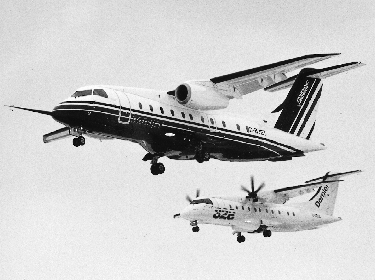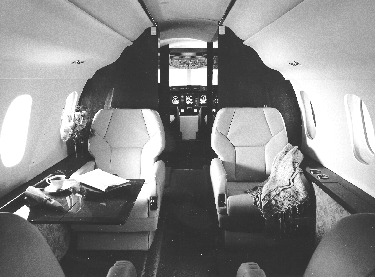
Andrzej Jeziorski/MUNICH
When the completed Fairchild Dornier 328JET was first shown to Reinhold Birrenbach, head of the 328 project since its turboprop days, he must have felt a little self-satisfied.
"This is the way the aircraft always should have looked," he said, observing the clean lines of the newly fitted Pratt &Whitney Canada PW306B turbofans mounted under the wing, replacing earlier P&WC PW119B turboprops.
Fairchild Dornier president Jim Robinson recalls that, soon after Fairchild Aircraft took over 80% of the former Daimler-Benz Aerospace (Dasa)regional aircraft subsidiary, he asked whether any thought had been given to a jet version. Birrenbach excused himself and came back a little later with a pile of documents - the results of a 328 jet study carried out many months before, and rejected out of hand by the company's former management.
Then, the 328 turboprop project was a millstone around Dasa's neck. With a maximum cruise speed of 335kt (620km/h), the 30-seat aircraft's advanced design made it the fastest turboprop in its class. Nevertheless, that speed still fell 10kt short of Dornier's initial target, and was 33kt slower than Saab's 50-seat 2000 turboprop.
'OVER ENGINEERED'
The aircraft was also 1,000kg heavier than first hoped, and was accused by its critics of being over-engineered. The 328 was quiet and comfortable to fly in, but high production costs and a sluggish market left Dasa losing millions of deutschmarks on each aircraft sold, and it became even less attractive to cash-conscious operators. Dasa was forced to shelve plans for a 50-seat stretched version to avoid competition with the Fokker 50, produced by the German company's former Dutch subsidiary.
Much has changed since then. Dasa backed out of Fokker, leaving the remains of that company clutching desperately at one rescue plan after another. The German manufacturer also sold all but 20% of Dornier Luftfahrt to Fairchild, under secret conditions said to have been heavily weighted in the US company's favour.
In a final, savoury, twist to the tale, it has been the 328's very "over-engineered" structure, referred to more generously by Robinson as "conservative German engineering", which made it easy to convert the aircraft into a jet at a time when more operators were catching on to the fact that this is what their passengers want.
Fairchild Dornier carried out a worldwide survey of 50 airlines between October 1996 and January 1997, which showed that the market preferred jets, provided that their economics and performance were competitive. The survey also revealed the desire for a family of aircraft with maximum commonality.
As a result, the company launched the 328JET formally in early February 1997, along with a proposal for a 50-seat stretched variant. The first orders were announced in June 1997 at the Paris air show, with six firm from Dijon-based Proteus Airlines, and four more - with four options - from Aspen Mountain Air in the USA.
The main structural modifications required were to fuselage frames 24 and 26 - the wing and landing-gear attachment frames. These are machined from solid, says senior vice-president for product development Earl Robinson, and all that needed to be done was to reduce the amount of material machined away, leaving the frames stronger, and to reinforce the wing-attachment points. Reinforcements were also made to the trailing link of the landing gear.
Rather than having a single hydraulic system, the 328JET has a dual system. Some 200litres of fuel capacity has been added, along with two additional fuel pumps and 30% -larger-diameter fuel lines. Robinson says that the engineers predict conservatively that the jet will consume about 30% more fuel than the turboprop does, although "first indications are that we are significantly better than that". Modifications have also been made to the engine attachments and cockpit instrumentation.

LOWER OPERATING COSTS
According to Fairchild Dornier, 328JET direct operating costs (DOCs) are consistently lower than those for competing aircraft, and become lower than those of the turboprop 328 on routes exceeding 370km (200nm).
The aircraft has so much commonality with its turboprop stablemate that Robinson believes that a common type rating could cover both aircraft, with an additional week's training required to familiarise pilots with the jet's systems.
Jim Robinson says that the original 328 was aerodynamically a 365kt design. When the 328JET programme was revealed, its target cruise speed was 375kt. This was slow for a turbofan, although Fairchild Dornier was hoping that the high climb rate would compensate.
Now, with a 0.1m extension to the trailing-edge flaps, aerodynamic drag has been cut to bring the maximum cruise speed up to 400kt, or possibly more. The aircraft's aerodynamics are so slick that, when the engines are set to flight idle, the aircraft begins to decelerate at only 1kt/s, says test pilot Meinhardt Feuersenger.
The aircraft has an unusual wing planform, with parallel edges inboard of the engines, a trapezoidal form outboard, and high sweep on the leading edge, near the wingtips. The wing design combines with the 27kN (6,100lb)-thrust of each of the turbofans to give the aircraft an impressive climb rate:14.2min to 31,000ft.
One recent test flight included a power climb from 20,000ft (6,100m) to 25,000ft. Sitting in the 328 turboprop chase plane, Earl Robinson remembers with some satisfaction what happened when the pilots of both aircraft engaged full power simultaneously. "In a matter of seconds, the jet was thousands of feet above us and several miles ahead of us. We had to ask for a turnaround so we could rejoin," he recalls.
This type of climb performance means that the 328JET will reach its cruise altitude and its cruise speed, while its competitors - which up to now consist exclusively of the Brazilian Embraer RJ-135 - are still in the climb. As a result, Fairchild Dornier claims that, despite the aircraft's lower maximum cruise speed, its block times will be "comparable or better than [competitors'] on flight distances typical for regional jet aircraft". The wing design also contributes to the short-field performance, with a required take-off field length of 1,240m and a landing field length of 1,185m.
So far, Fairchild Dornier has stuck to its programme schedule to the day. The completed prototype aircraft - originally the second turboprop prototype airframe - was rolled out for the press on 6 December, and the first flight took place on 20 January, although Earl Robinson jokes that he was scolded for missing the planned 11.00 take-off time by 16 minutes.
The first flight lasted nearly 2h, flying south over the Bavarian Alps and reaching an altitude of 25,000ft and an airspeed of 220kt. At the controls were Feuersenger and former Eurofighter EF2000 test pilot Peter Weger.

PERFORMANCE
Three flights, totalling 6h 25min, had taken place by the day of the aircraft's public premiere. The programme involves testing "-not only the performance, but everything that makes this aircraft different from the turboprop", says Feuersenger. With the elimination of propeller wash, the airflow over the wings is smoother, so there is no need to retrim with every change in power settings. Performance measured to date has met or exceeded computer predictions. Flight testing will continue until December, followed by European and US type certification in the first quarter of 1999.
The company is to avoid the relatively crowded 50-seat market, and has chosen instead to go for a 42- to 44-seat variant, called the 428JET. This aircraft will be stretched with a 3m fuselage plug, a further 50-80mm extension to the trailing-edge flaps and about 1m added to the wingspan. The powerplants will also be PW306Bs, uprated to some 29.4kN thrust.
According to Jim Robinson, interest in the 428JET is high, particularly among US airlines. Although the aircraft may have degraded short-field performance, the additional seats and high commonality with the 328JET make the stretch an attractive proposition, argues Robinson. A formal go-ahead could come in April.
Further-reaching plans also exist for a larger regional jet family based on a 70-seater, known as the 728JET, which could later be stretched to the 90-seat 928JET. These could be launched concurrently with the 428JET, and Fairchild Dornier says that it expects letters of intent "-from two or three European carriers".
Presentations on the 728JET have been made to carriers including Crossair, Eurowings and Lufthansa, and appear to have aroused serious interest, at least in Europe. "We have talked to US airlines, but none has joined at this point. The USmarket [for 70-seaters] is developing more slowly," says Robinson.
Eurowings says that it would like the programme to go ahead, but in the five abreast version rather than the four-abreast alternative, as the wider cabin would make the 928JET stretch possible. The German carrier says, however, that it feels that airlines will be likely to commit to an order only if Fairchild Dornier succeeds in establishing the types of risk-sharing partnerships for which it is hoping, rather than pursuing the programme on its own - a venture which Eurowings feels would be too risky.
RISK-SHARING PARTNERS
The manufacturer is looking for risk-sharing partners to supply the engines, wing and fuselage of the aircraft, but is "-not talking to other airframers", says Robinson. The most likely powerplant suppliers are General Electric, with its CF34-8C1, Pratt & Whitney Canada/ Snecma with the SPW14 and Allison with the AE3012. BMW Rolls-Royce's BR710 has also been discussed, but would only be suitable for the stretched aircraft, which requires a 66kN-thrust engine compared with the 55kN thrust required for the basic 728JET.
According to Earl Robinson, a bid for the wing has been received from a partnership of Textron Aerostructures and Kawasaki, AIDC of Taiwan and South Korea's Samsung. The company's immediate focus, however, is on marketing the 30-seater. The orderbook has been growing steadily in recent months, with 20 firm, 15 options and three more orders imminent for the corporate-jet version of the aircraft.
Talks are under way in the USA for five large sales, totalling over 400 firm orders and options. Production rates at Oberpfaffenhofen are primed to rise from 25 328JETs in the 1998/9 business year to 72 in 2001/2.
When the proposal for a jet version of Dornier's problem child first became public in August 1996, it was greeted with some scepticism. Jim Robinson responded at the time that "the proof is in doing it, not talking about it".
Fairchild Dornier now appears to be giving substance to these words.
Source: Flight International























